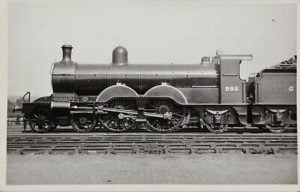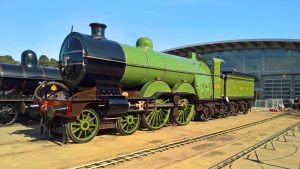
Britain’s first 4-4-2 ‘Atlantic’ type locomotives, the Great Northern Railway’s (GNR) C1 small and large boiler were the predecessor to Nigel Gresley’s A1, A3 and A4 4-6-2 ‘Pacific’ engines on the East Coast Mainline.
In this week’s Sole Survivor will we look back on the history of the GNR C1 small boiler (London and North Eastern Railway (LNER) C2 Class), GNR C1 large boiler (LNER C1 Class) and last member of each class preserved.
GNR C1 (small boiler) / LNER C2 and GNR C1 (large boiler / LNER C1 Class
On his appointment as Locomotive Superintendent of the GNR in 1895, Henry Ivatt had the difficult task of replacing the Stirling ‘Singles’ a few years into his role.
Following his rebuilds of the E1 and D4, Ivatt was then granted permission to built a 4-4-2 to succeed the legendary ‘singles’.
Design
The most notable feature of the prototype approved by the GNR Directors in February 1897 was the use of the 4-4-2 or ‘Atlantic’ wheel arrangement. Originating in America nine years earlier in 1888, the 4-4-2 was the next logical step in the development of many steam locomotive designs in Britain. The key benefits to using a trailing truck (wheels behind the coupled wheels, usually under the cab) are increased riding performance and to allow a boiler with a large firebox to be fitted.
Both of these were desirable for the express passenger duties along the East Coast Mainline. Ivatt shared a similar approach to steam locomotive design as Churchward on the Great Western Railway, with both ensuring their engines had good boilers. With the trailing truck allowing a large firebox, the boiler was designed to have a great steam raising capacity, which was proved in service.
Construction

Below is the list of engines built for both classes, listing when they were built, when the batch was ordered and details of the batch along with numbers.
- Built 1898 (Order 206 of February 1897) – Prototype engine for GNR C1 small boiler class No.990 “Henry Oakley” (one engine)
- Built 1900 (Order 218 of January 1899) – GNR C1 small boiler No.949, 950 and 982 to 989 (10 engines)
- Built 1902 (Unknown Order Number) – GNR C1 small boiler No.271 as four-cylinder simple (one engine)
- Built 1902 (Order 232 of May 1902) – Prototype engine for GNR C1 large boiler class No.251 (one engine)
- Built 1903 (Order 230 of December 1901) – GNR C1 small boiler No.252 to 260 and 250 (10 engines)
- Built 1904 (Order 236 of February 1903) – GNR C1 large boiler No.272 to 291 (20 engines)
- Built 1905 (Order 239 of May 1904) – GNR C1 large boiler No.292 built as four-cylinder compound (one engine)
- Built 1905 (Order 1904 by GNR, built at Vulcan Works) – GNR C1 large boiler No.1300 built as four-cylinder compound (one engine)
- Built 1905 (Order 240 of September 1904) – GNR C1 large boiler No.293 to 301 and 1400 (10 engines)
- Built 1905 (Order 241 of December 1904) – GNR C1 large boiler No.1401 to 1410 (10 engines)
- Built 1906 (Order 245 of August 1905) – GNR C1 large boiler No.1411 go 1420 (10 engines)
- Built 1907 (Order 248 of May 1906) – GNR C1 large boiler No.1421 built as four-cylinder compound (one engine)
- Built 1907 (Order 249 of September 1906) – GNR C1 large boiler No.1422 to 1431 (10 engines)
- Built 1907 and 1908 (Order 253 of March 1907) – GNR C1 large boiler No.1432 to 1441 (10 engines)
- Built 1908 (Order 255 of October 1907) – GNR C1 large boiler No.1442 to 1451 (10 engines)
- Built 1910 (Order 263 of February 1910) – GNR C1 large boiler No.1452 to 1461 (10 engines)
On the Track
Footplate crews soon found the engines had boilers which could produce more steam than the cylinders could use, with crews often pushing the locomotives to their maximum performance. There were issues with the class, but ultimately they handled the GNR’s top express passenger work for just over two decades, up until the formation of the London and North Eastern Railway in 1923, with two Gresley A1 locomotives in service at this point.
One feature that didn’t help was the fact the size of the cylinders was too small for the boiler size and also the type of lever reverser used. On top of being difficult to use, the preset cutoff percentages (the higher the percentage, the more steam entering the cylinders), lead to higher coal and water consumption. Poor riding was another issue which was reported across both classes, especially when engines had run high mileage since their last overhaul.
As the classes were the top express passenger engines on the GNR, the locomotives were allocated along the GNR’s section of the East Coast Mainline (ECML) at Kings Cross, New England (Peterborough), Grantham and Doncaster. Early on in LNER ownership transfers saw both classes move further North, up to Edinburgh in some cases, when they introduced new services, especially while only a small number of Gresley A1s were in service. Later under LNER ownership Sheffield and Cambridge became home to some engines.
Improvements and Modifications
Both Ivatt and Gresley trialled many improvements, most notable being the formation of the larger boiler C1 class. Other changes included using both two and four-cylinder arrangements, cylinder diameter, simple and compound expansion, Walschaerts and Stephenson valve gear, different types of superheating, booster (using two small cylinders and steam from the boiler, to provide power to the trailing truck, increasing tractive effort. In order to improve the booster’s use, many alterations, including to the draughting arrangement, were tried.)
Decline and Withdrawn
Throughout the 1920s and early 1930s, the Gresley A1s and A3s grew in numbers, along with the A4s from 1935. Both classes would at first be transferred onto other express passenger services, before secondary and standby duties for failed engines. The last Ivatt Atlantics were withdrawn in the early 1950s, with these engines being built almost 50 years previous.
Preservation
GNR C1 (small boiler) / LNER C2 – 990 “Henry Oakley”

The LNER had formed a museum at York for unique engines to preserve them when they had been withdrawn from traffic on the LNER, which following cosmetic restoration back into GNR livery and number, 990 “Henry Oakley” entered York Museum in 1938, later becoming the only example saved for preservation.
Like many preserved pre-grouping engines in the 1950s and 60s, 990 was overhauled in 1953 and returned to traffic in GNR livery to haul enthusiast special trains and celebrate the 100th anniversary of Doncaster Works where “Henry Oakley” was built.
990 was brought out of retirement again and put into steam for the 150th-anniversary celebrations for the Stockton & Darlington, followed by running on the Keighley and Worth Valley Railway in 1977.
Since then “Henry Oakley” has been a static display mostly at either the National Railway Museum (NRM) York or Shildon, with visits to other museums to from time to time.
GNR C1 (large boiler) / LNER C1 Class – 251

Following a similar preserved life as 990, 251 was withdrawn from service on the LNER in 1947, entering Doncaster Works for a rebuild to return the engine back to a condition closer to when it was new.
This included swapping many major components, such as refitting slide valves and a saturated (non-superheated) boiler, with parts obtained from other classmates.
251 also joined 990 to haul mainline tours, needing to double head with another engine due to poor steaming.
Since then 251 has been a static display in NRM York or Shildon.
We hope you have enjoyed this long-awaited Sole Survivor article. You can view more of the Sole Survivor series here.
Where Next?
RailAdvent Plus
Get image downloads, Prints and Streaming Video
RailAdvent News
The latest railway news
RailAdvent Shop
Railway Prints, DVD’s / Blu-Ray’s and more
LocoStop Community
Come and share your railway pictures
Mainline UK Steam Info
Upcoming mainline steam tours/loco movements






Responses